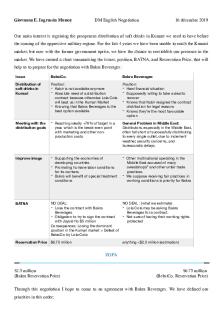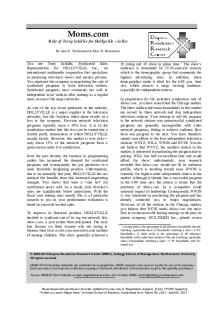Moms.com - Seller - Negotiation document PDF

| Title | Moms.com - Seller - Negotiation document |
|---|---|
| Course | Mechanism Design |
| Institution | Indian Statistical Institute |
| Pages | 5 |
| File Size | 277.9 KB |
| File Type | |
| Total Downloads | 116 |
| Total Views | 343 |
Summary
Negotiation document...
Description
Moms.com Role of Terry Schiller for Hollyville - Seller By Ann E. Tenbrunsel & Max H. Bazerman
You are Terry Schiller, Syndicated Sales Representative for HOLLYVILLE, Inc., an international multimedia corporation that specializes in producing television shows and motion pictures. You represent the company in negotiating the sale of syndicated programs to local television stations. Syndicated programs most commonly are sold to independent local stations after running as a regular show on one of the major networks. As one of the top seven producers in the industry, HOLLYVILLE is a major supplier to the television networks, but this business taken alone results in a loss to the company. First-run network television programs typically incur a 20% loss. It is in the syndication market that this loss can be turned into a sizable profit, transactions at which HOLLYVILLE usually excels. However, this market is very risky— only about 15% of the network programs from a given season make it to syndication. Over the past decade, the increase in programming outlets has increased the demand for syndicated programs and consequently has put producers in a more favorable bargaining position. Unfortunately, due to an unusually bad year, HOLLYVILLE has not realized the benefits from this increased negotiating strength. Two shows that were a “sure bet” for syndication never sold. As a result, your division’s sales are significantly below projections. With the fiscal year ending next month, this is of particular concern to you as your performance evaluation is based on year-end booked sales. To improve its financial position, HOLLYVILLE decided to syndicate one of its top ten network hits, Moms.com, a year earlier than anticipated. The story line focuses on three women who are trying to balance their lives as dot.com executives and mothers of teenage children. This show generally achieved a
20 rating and 30 share in prime time.1 The show’s audience is dominated by 25-54-year-old women, which is the demographic group that commands the highest advertising rates. In addition, these demographics make it ideal for the 6:00 p.m. time slot, which attracts a large viewing audience, especially for independent stations. In preparation for the potential syndication sale of Moms.com, you have researched the Chicago market. The three million television households in this market are served by three network and four independent television stations. Your attempt to sell the program to the network stations was unsuccessful; syndicated programs are generally incompatible with other network programs, failing to achieve audience flow from one program to the next. You have therefore turned your efforts to the four independent television stations: WXYZ, WILL, WWIN and WCHI. You do not believe that WXYZ, the smallest station in the market, is interested in purchasing the program due to pricing. WILL has had an excellent year and could afford the show; unfortunately, your research revealed that Moms.com would not fit its audience profile, which is trending toward men. WWIN is currently the highest rated independent station in the market. Although it already has a successful program in the 6:00 time slot, the station is aware that the purchase of Moms.com by a competitor could seriously impact its leadership. Consequently, WWIN is very interested in purchasing the program and has already contacted you to begin negotiations. However, of all the stations in the Chicago market, you believe that WCHI needs Moms.com the most. Due to an unsuccessful buying strategy in the past, its parent company, MULTIMED Inc., placed severe 1
A rating point is the percentage of all television households that are watching a particular show (# households watching a show / # TV households). A share point is the percentage of all television households with a television turned on that are watching a particular show (# households watching a show / # TV households with TV turned on).
© 2002-2014 Dispute Resolution Research Center (DRRC), Kellogg School of Management, Northwestern University. All rights reserved. DRRC/KTAG teaching materials are protected by copyright law. DRRC requires a per person royalty for use of its exercises. Each purchase of an exercise authorizes copying or electronic distribution of that exercise equal to the quantity purchased. Access DRRC/KTAG materials at www.negotiationexercises.com Contact DRRC at [email protected]
Reproduced with permission from the publisher for use only in “Negotiation Analysis_[Term 7:PGP]” taught by “Professor Leena Kinger Hans” at Indian School of Business, Hyderabad from “March 08, 2021 - April 08, 2021.”
buying restrictions on the station during the last three years. While these restrictions stabilized WCHI's financial position, in the process, the station lost its independent audience leadership to WWIN and is now a poor second with weak demographics. WCHI desperately needs strong new programs for the upcoming season. You think that Moms.com is just the show it needs.
throughout the life of the contract. If the agreement goes beyond 6 runs, you believe that each “extra run” will end up costing you $250,000 in today's dollars (i.e., 7 runs/episode will cost you $250,000, 8 runs/episode will cost you $500,000, etc.). However, if the agreement involves less than 6 runs/episode, you believe that it will save you $250,000 for each decrease in the number of runs (i.e., 5 runs/episode will save you $250,000, 4 runs/episode will save you $500,000, etc.). HOLLYVILLE policy specifically states that any agreement with more than eight runs per episode is not acceptable.
Your job is to get the best deal possible for Moms.com. Moms.com will end its network run with 100 episodes available. These 100 episodes are being offered as part of a 5-year contract; the length of this contract is non-negotiable. In determining the value of the show to potential buyers, you realize that their advertising revenue is based on the demographic number, or the rating within the primary demographic category (in this case, 25-54-year-old women). You estimate that if the show were to achieve 2-3 ratings points within this demographic category, it would create advertising revenue for WCHI somewhere between $6,000,000 and $8,000,000 over the life of the contract, with every increase in demographic rating point adding an additional $500,000 $1,500,000 in revenue. While you expect that the show will achieve a demographic rating in the 5-6 range, you also recognize that this number is uncertain. As a result, you have made estimates of the likely rating points that this show will achieve in syndication: Ratings
Likelihood
2-3 3-4 4-5 5-6 6-7
10% 10% 10% 50% 20%
You generally request financing terms that require 50% payment up front and 25% each in years 1 and 2. Buyers, on the other hand, generally prefer to delay payments. Your financial group has helped quantify the cost of delayed payment by specifying the money that is lost for each payment made in years 1-3. HOLLYVILLE will not allow you to accept any deal in which money would be paid beyond three years. Payment
You Lose
up front 1st year
0% of the money paid in this year 20% of the money paid in this year
2nd year 3rd year
35% of the money paid in this year 50% of the money paid in this year
Although Moms.com will be sold for viewing this season, your relationship with the buyer of Moms.com will continue as future shows become available. You are interested in selling another show for the upcoming season, a program called Juniors that centers on high-school students in their junior year. Unfortunately, because this show appeals almost exclusively to the teenage market segment, which commands low advertising rates, it is a tough sell. In fact, you have failed to sell Juniors to any of the network stations. Because you are eager to sell this program in the Chicago market, you are willing to accept a reasonable price. WXYZ has offered to pay a $10,000 licensing fee per episode for the show’s 100 episodes. However, you hope to sell the program for more than this in future negotiations with other stations.
The revenue you receive from the show is determined by multiplying the agreed-upon licensing fee per episode by the number of available episodes (in this case, 100). Because of its audience potential, you would not be willing to accept a fee less than $35,000 per episode; optimistically, you would like to receive $70,000 per episode. You also know that WWIN is going to make you an offer for the show and that this offer has an estimated net value of $2.5 million dollars.
You are about to meet with Kim Taylor of WCHI to discuss the sale of Moms.com. The attached "Negotiation Agreement Worksheet" found on page 4 can be used to help evaluate the net worth of any negotiated deal. In addition, a sample calculation using this format is found on page 5. You are not limited to the structure presented; rather, this sheet is intended to help you organize the various pieces of a
You place some significance on not overexposing the show in order to maintain its potential value beyond the five years of the contract. The revenues described above were based on 6 runs per episode, which means that the station could run the same episode 6 times
2
Moms.com/Role of Seller
Reproduced with permission from the publisher for use only in “Negotiation Analysis_[Term 7:PGP]” taught by “Professor Leena Kinger Hans” at Indian School of Business, Hyderabad from “March 08, 2021 - April 08, 2021.”
runs/episode. If the number of runs/episode is equal to 6, no adjustment is necessary.
negotiated agreement and to provide a reasonable basis for evaluating the worth of any proposed deal. While you may reach agreements not found on this chart, you must base your decisions only on the factual information presented in the case. Regardless of how you formulate the information, any agreement you reach must specify the following:
5. Other Pieces of the Agreement. If any other items are relevant to the agreement, the item(s) and corresponding value/cost should be specified. 6. Net Revenue. To calculate net revenue, add the runs/episode adjustment and the value of other pieces of the agreement to the “Program Revenue less Financing.”
1. Program Revenue. To calculate the program revenue, multiply the agreed-upon licensing fee per episode by 100 (the number of available episodes).
7. Value of the Alternative Deal. The value of the alternative deal is the expected value of your “next best offer.” For HOLLYVILLE, this is the value of the offer that you believe WWIN is going to submit. As stated above, you estimate that this offer has a net value of $2.5 million dollars.
2. Financing Cost. To calculate the financing cost, multiply any payments that will be made in years 1-3 by the percentage lost for each year. For example, any payments that will be made in year 1 should be multiplied by 20%. The total financing cost can be determined by adding up the annual cost for all 3 years.
8. Net Value of the Bargaining Agreement. To determine the net value of the bargaining agreement, subtract the value of the alternative deal from the net revenue.
3. Program Revenue less Financing. To determine the program revenue less financing, subtract the financing cost from the program revenue. 4. Runs/Episode Adjustment. If the number of runs/episode is greater than 6, $250,000 must be subtracted for each additional run/episode. If the number of runs/episode is less than 6, $250,000 should be added for each decrease in the number of
Upon completion of a deal, please fill out the “Negotiation Agreement Worksheet” and give it to the lecturer.
3
Moms.com/Role of Seller
Reproduced with permission from the publisher for use only in “Negotiation Analysis_[Term 7:PGP]” taught by “Professor Leena Kinger Hans” at Indian School of Business, Hyderabad from “March 08, 2021 - April 08, 2021.”
NEGOTIATION AGREEMENT WORKSHEET (See example on next page.) 1.
Program Revenue Licensing Fee/Episode x 100 episodes
2.
Financing Cost Payments in Year 0 * 0.00 Payments in Year 1 * -0.20 Payments in Year 2 * -0.35 Payments in Year 3 * -0.50 Total Financing Cost
3.
Program Revenue less Financing (1) – (2)
4.
Runs/Episodes Adjustment If 4, + $500,000 If 5, + $250,000 If 6, no adjustment If 7, - $250,000 If 8, - $500,000
5.
Other Pieces of the Agreement (Specify)
6.
Net Revenue (3) + (4) + (5)
$ 2,500,000
7.
Value of the Alternative Deal
8.
NET VALUE OF BARGAINING AGREEMENT (6) – (7)
4
Moms.com/Role of Seller
Reproduced with permission from the publisher for use only in “Negotiation Analysis_[Term 7:PGP]” taught by “Professor Leena Kinger Hans” at Indian School of Business, Hyderabad from “March 08, 2021 - April 08, 2021.”
EXAMPLE: NET VALUE CALCULATION The following example is provided to guide you in assessing the worth of a sample agreement. You should make no assumptions about the quality of this agreement; your analyst has provided it simply to help you understand how to assess the worth of deals that might come up in your negotiation. Assume that you have reached an agreement for the sale of Moms.com that specifies the following terms: • • •
licensing fee: $50,000 runs/episode: 5 financial terms: Year 0: 50% Year 1: 30% Year 2: 20%
The calculation of the net value of this agreement is described below. 1.
$ 5,000,000
Program Revenue Licensing Fee/Episode x 100 = $50,000 x 100 = $5,000,000
2.
$ 650,000
Financing Cost YR
Payment
Cost (%)
0 1 2
0.5 * $5,000,000 = $2,500,000 0.3 * $5,000,000 = $1,500,000 0.2 * $5,000,000 = $1,000,000
0% 20% 35%
Cost ($) $0 $300,000 $350,000
Total Cost 3.
$650,000 $ 4,350,000
Program Revenue less Financing Cost $5,000,000 - $650,000 = $4,350,000
4.
Runs/Episode Adjustment
5.
Other Pieces of the Agreement
6.
Net Revenue
$ 250,000 $0 $ 4,600,000
$4,350,000 + $250,000 + $0 = $4,600,000 7.
Value of the Alternative Deal
$ 2,500,000
8.
NET VALUE OF THE BARGAINING AGREEMENT
$ 2,100,000
Net Revenue - Value of the Alternative Deal $4,600,000 - $2,500,000 = $2,100,000
5
Moms.com/Role of Seller
Reproduced with permission from the publisher for use only in “Negotiation Analysis_[Term 7:PGP]” taught by “Professor Leena Kinger Hans” at Indian School of Business, Hyderabad from “March 08, 2021 - April 08, 2021.”...
Similar Free PDFs

Best seller
- 4 Pages

3.Unpaid Seller
- 3 Pages

Right of unpaid seller
- 2 Pages

Starbucks Negotiation
- 3 Pages

Negotiation class
- 2 Pages

Riassunto Anatomia del best seller
- 11 Pages

DM English Negotiation
- 3 Pages

Bargain theory of negotiation
- 6 Pages

Negotiation notes - Dave Lawson
- 6 Pages

5. Harvard Negotiation Checklist
- 2 Pages

Negotiation Planning Template
- 1 Pages
Popular Institutions
- Tinajero National High School - Annex
- Politeknik Caltex Riau
- Yokohama City University
- SGT University
- University of Al-Qadisiyah
- Divine Word College of Vigan
- Techniek College Rotterdam
- Universidade de Santiago
- Universiti Teknologi MARA Cawangan Johor Kampus Pasir Gudang
- Poltekkes Kemenkes Yogyakarta
- Baguio City National High School
- Colegio san marcos
- preparatoria uno
- Centro de Bachillerato Tecnológico Industrial y de Servicios No. 107
- Dalian Maritime University
- Quang Trung Secondary School
- Colegio Tecnológico en Informática
- Corporación Regional de Educación Superior
- Grupo CEDVA
- Dar Al Uloom University
- Centro de Estudios Preuniversitarios de la Universidad Nacional de Ingeniería
- 上智大学
- Aakash International School, Nuna Majara
- San Felipe Neri Catholic School
- Kang Chiao International School - New Taipei City
- Misamis Occidental National High School
- Institución Educativa Escuela Normal Juan Ladrilleros
- Kolehiyo ng Pantukan
- Batanes State College
- Instituto Continental
- Sekolah Menengah Kejuruan Kesehatan Kaltara (Tarakan)
- Colegio de La Inmaculada Concepcion - Cebu

![Negotiation Memo [Moms.com– Seller] gsb635](https://pdfedu.com/img/crop/172x258/gwrwllmyoe31.jpg)


